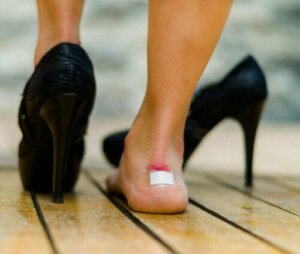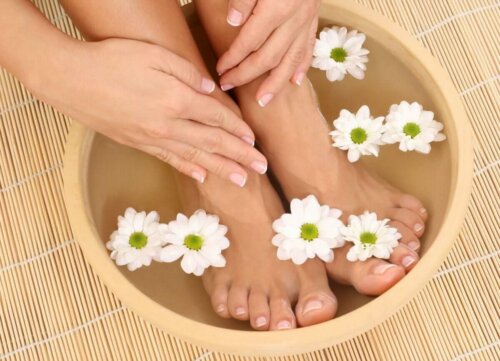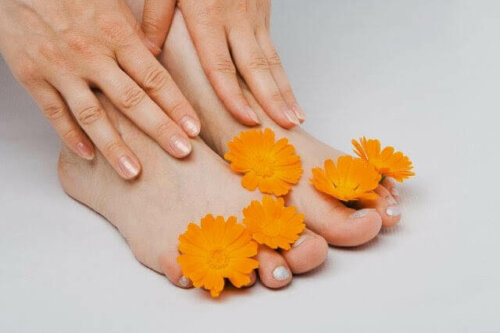9 Remedies for Healing Blisters on the Feet

Who hasn’t had blisters on the feet? You probably already know how annoying these can be. Luckily, there are some natural remedies you can try.
A blister is a tiny sac filled with clear liquid on the outer layer of skin and is usually the result of friction and heat but may also be due to certain illnesses.
You can use some natural remedies to heal those that occur as a result of friction, be it due to tight shoes or walking for a long period, according to popular belief.
Well, more than remedies, these are more like tips that might help you prevent discomfort while wearing socks and shoes when you already have blisters on the feet.
1. A saline solution can help you heal blisters on the feet

Soaking the feet in a basin of warm water with plenty of salt can soften a blister. You can then use a sterilized needle to pierce the blister and drain the liquid. It’ll start to dry out immediately after.
Once you’ve soaked your feet in the water, be sure to dry them thoroughly with a towel. Check the blister now and then to make sure it’s truly dry. Dry any fluid coming out of it with a cotton ball or a swap.
Note: Salt can apparently improve skin defenses and help prevent infections.
2. Garlic paste
According to popular belief, you can make a healing paste by peeling and crushing a clove of fresh garlic and applying it to the blister on your feet. According to such beliefs, peeling a clove of garlic and holding it lightly against the blister for five to 10 minutes can be useful.
Be aware that these methods aren’t that effective and can irritate the blister further.
3. Aloe vera
This plant is one of the most recommended natural remedies due to the healing properties some attribute to it. According to popular belief, applying it to blisters could help you hydrate the area, reduce inflammation, and speed up healing.
4. Common marigold

Because of its anti-inflammatory properties, marigold is one of the most common ingredients when it comes to making skincare products. As a result, many people recommend using an ointment made with it (or products containing it) in the treatment of blisters.
Discover Improve the Appearance of Varicose Veins with Olive Oil and Marigold
5. Apple cider vinegar
When it comes to treating recent blisters, many people also recommend using apple cider vinegar. This is because they believe its acidity and unique composition is antimicrobial and could heal a blister that’s already burst.
Some people dilute a teaspoon of vinegar in water for a disinfectant foot bath. However, you have to be careful with this as vinegar can dry your skin and irritate it further.
6. Cornmeal
Some believe that applying a mixture of cornmeal and honey to the blisters on your feet can heal them. They usually make a paste with both ingredients, apply it to the affected area, and allow it to do its thing.
7. Vaseline
Some say you can also use vaseline to treat blisters. They usually applying a little bit of it directly to the blister to soften and remove it without further damage to the skin.
8. Carrot paste to treat blisters on the feet
Another home remedy people recommend for treating blisters is carrot paste. Like the others, you would simply make a paste with carrots, apply it to the blister, and let it do its thing. The way it works is it apparently softens the blister and allows you to remove it more easily.
Note: Other people make a paste made with powdered aspirin and water and place it on their skin. They do so to relieve inflammation and facilitate the removal of the blister.
9. Alcohol
This home remedy only consists of using this common household ingredient usually present in your first aid kit.
Some people believe that dipping a cotton swab in alcohol and applying it to your blisters could help you soften and eliminate them, while cleansing your skin and preventing infection.
Note: Some apply hand sanitizer instead of alcohol.
Remedies to cure blisters on other parts of the body
Some viral infections can cause this type of lesion on the lips. A common case is that of herpes simplex infection.
This type of sores usually heal on their own but can also cause discomfort, pain and irritation. For this, you can try a lemon balm extract or essence.
To use it, dilute a few drops in water or a base oil (almond, olive, sesame, etc.) and carefully apply it on the blisters. Don’t apply the essence directly as it could irritate your skin.
Another skin condition, dyshidrosis or dyshidrotic eczema, causes blisters on the fingers and palms of the hands. These often manifest as dry, itchy skin and require medical treatment. But, you can apply coconut oil to soothe, moisturize the skin, and reduce inflammation in the meantime.
Preventing the appearance of blisters on the feet
There are proven treatments for this skin problem but it’s always best to prevent them. Of course, this is hard to do when the cause dyshidrosis or herpes. Still, you can prevent those caused by friction.
To do so:
- Wear comfortable, well-fitting shoes.
- Also, wear loose-fitting, breathable clothing while exercising.
- Wear moisture wicking socks.
- Apply soft bands or cloth to affected areas such as thighs, heels and toes. Wear gloves if they tend to appear on your hands.
In addition, once they appear and you have no choice but to resort to a home remedy, be sure to wash your hands in a clean comfortable place. Consult a doctor if you notice any signs of infection, especially if you have diabetes and circulation problems.
What is the most useful remedy to cure blisters on the feet?
Of all the remedies to cure blisters above, the most useful might be the saline solution. But, try the one that most appeals to you.
Remember, you must keep any burst blister well ventilated so don’t put band-aids on it. Also, try to wear comfortable footwear.
All cited sources were thoroughly reviewed by our team to ensure their quality, reliability, currency, and validity. The bibliography of this article was considered reliable and of academic or scientific accuracy.
- Dominguez-Fernández R. N, Arzate-Vázquez I, et al. El gel de aloe vera: estructura, composición química, procesamiento, actividad biológica e importancia en la industria farmacéutica y alimentaria. Revista Mexicana de Ingeniería Química. 2012. 11 (1): 23-43.
- Jantsch J, Schatz V, et al. Cutaneous Na+ storage strengths the antimicrobial barrier function of the skin and boosts macrophage-driven hosts defense. Cell Metabolism. 2015. 21. 493-501.
- Kumar Bubna A. Aspirin in dermatology: revisited. Indian Dermatology on line Journal. Noviembre-Diciembre 2015. 6 (6): 428- 435.
- Padilla Evangelista M. T, Abad-Casintahan F, Lopez Villafuerte L. The effect of topical virgin coconut oil in SCORAD index, trasnepidermal water loss, and skin capacitance in mild to moderate pediatric atopic dermatitis: a randomized, double – blind, clinical trial. International Journal of Dermatology. Enero 2014. 53 (1): 100-8.
- Schnitzler P, Schuhmacher A, et al. Melissa officinalis affects inactivity of enveloped herpesviruses. Phytomedicine. Septiembre 2008. 15 (9): 734-40.
- Siañez-González, C., Pezoa-Jares, R., & Salas-Alanis, J. C. (2009). EPIDERMÓLISIS ampollosa congénita: revisión del tema. Actas Dermo-Sifiliográficas. https://doi.org/10.1016/S0001-7310(09)72912-6.
- Tabatabai Naeini A, Miri R, Shafiei N. Effects of topical application of Calendula officinalis gel on collagen and hydroxyproline content of skin in rats. Comparative Clinical Pathology. Junio 2012. 21 (3).
This text is provided for informational purposes only and does not replace consultation with a professional. If in doubt, consult your specialist.








